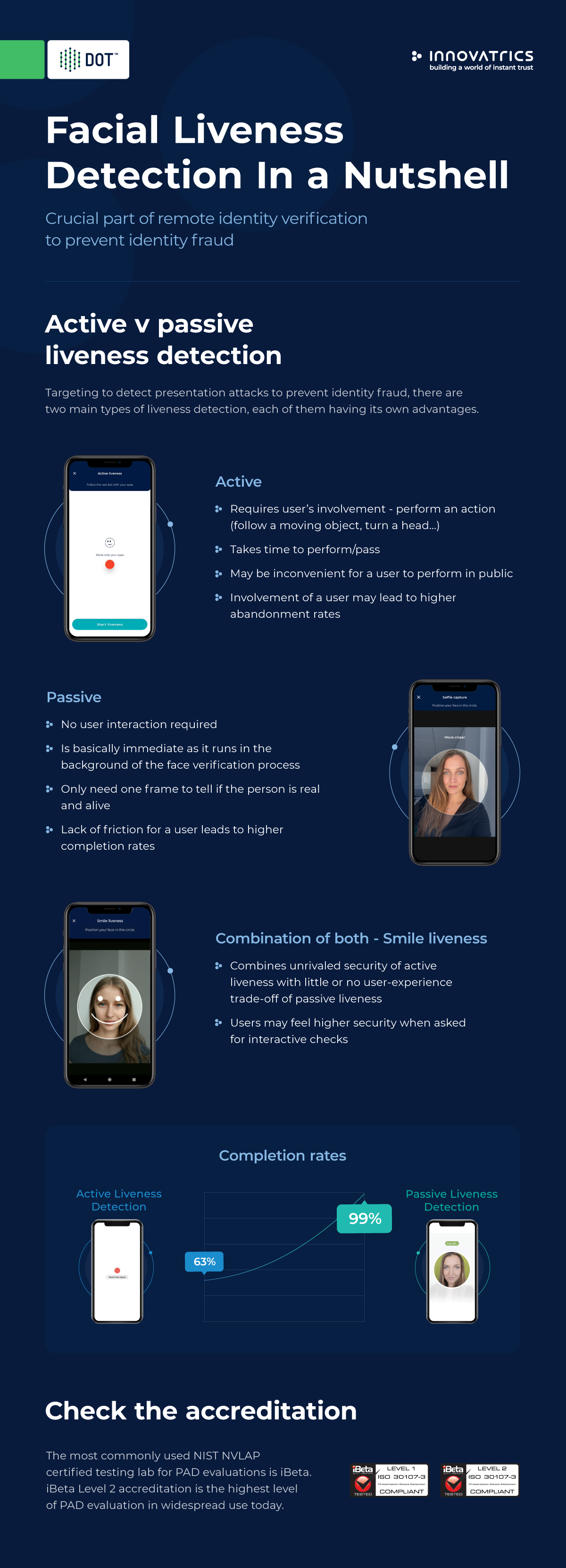Liveness Detection definition
Liveness detection is a technique where an algorithm securely detects whether the source of a biometric sample comes from a fake representation or is a live human being. The biometric sample is a facial photo taken by a user. The algorithm is able to recognize a live person from presentation attacks, for example, masks, photos, or videos.
What Is Liveness Detection?
An AI-based liveness detection algorithm distinguishes live human beings’ (real fingerprint, real iris, or real face) approaches from fake approaches (spoof attack, presentation attack) to the system. This process is called liveness detection.
Liveness detection was first used in 1950 by Alan Turing, the father of modern computer science. The experiment was called the Turing test, where he tested the intelligent behavior of a machine and its ability to generate responses similar to a human. The test consisted of an evaluator, aware that one of the conversation subjects was not a human. They communicated by typing on a keyboard. If the evaluator was not able to recognize a human from a machine, the machine passed the test.
Later on, in 2000, the first liveness check was performed similarly to the ones we know nowadays. Users were prompted to perform some actions on a video. However, the liveness detection technology back then was very slow and inaccurate. The first generation of liveness detection was an active one.
Types of Liveness Detection
There are two types of liveness detection – active and passive liveness detection. Both differ in terms of user interaction.
Recently, we have observed that some tech providers offer so-called semi-passive liveness detection checks. They aim to combine the best of both types of liveness detection for high security with a positive user experience. For example, during the so-called Smile Liveness, users are asked to simply smile.
As the world goes more digital, we’re witnessing more and more cases of online identity fraud. Organizations and businesses are constantly on the lookout for better security measures. One such safeguard to make remote identity verification more reliable is document liveness technology.
Liveness detection, in general, is part of the identity verification process that is mostly used in banks, telcos, eGovernment, and the sharing economy.
Passive Liveness Detection
Passive liveness detection is an innovative liveness detection method running in the background of the biometric facial verification process. Neural networks analyze the content of the biometric sample (i.e., a photo taken by a user) such as light, shadows, the texture of the skin, and other significant factors. This process usually does not end with an alert of a sufficient liveness check, which makes it more immune against spoof attacks. Passive detection is therefore a more seamless way to detect a presentation attack.
As in some types of use cases, a certain level of involvement of the user is required during the liveness check, so-called semi-passive liveness detection can be used. To enhance the security of the onboarding process while still maintaining the best possible user experience, the semi-passive liveness system prompts the user to perform a simple task such as a smile.
Active Liveness Detection
Active liveness detection is historically the originator of liveness detection. It is a way to verify whether the source of a biometric sample comes from a human or if it is a type of presentation attack. Liveness is detected by prompting a user to perform a simple task like watching a moving object on a screen or performing some simple movement with one’s head.
The first active liveness detection consisted of a video where a user was prompted to show their ID or do some movements while recording themselves. Currently, an active liveness check lasts only a few seconds and there is no need to take a video. The technology behind it captures the movement of the pupils while following the subject, analyzing whether the action is a spoof attack or not.
There are multiple opinions on whether an active check is less accurate than a passive check. What is critical is establishing the right balance between security and the user journey.
How Does Liveness Detection Work?
Liveness detection is a process performed to detect a presentation attack. The technology verifies the source of a biometric sample and its critical features. It then decides whether it’s a live person or a spoof such as a silicon mask, photo, video, etc.
Liveness detection is performed by taking a selfie as a part of an identity verification process or digital onboarding. Liveness detection usually takes only a few seconds, depending on whether it is being performed as an active liveness check or a passive liveness check. Passive liveness can take only 1 or 2 seconds, while active liveness check can take more time.
Feel free to explore our advanced liveness detection solutions and discover how they work.
Infographic: Active Liveness vs. Passive Liveness Detection
What Are Typical Presentation Attacks?
To protect against identity fraud, it helps to understand how fraudsters operate. Let’s look at a few common scams:
Print Attacks
A fraudster gets hold of someone’s ID and a printed photo of that person. They try to use these to convince a company they’re the real person – maybe to get a loan they won’t have to pay back.
Liveness detection technology is here to tell if it’s looking at a real person or just a printed photo. It also compares the ID photo with the selfie the person provides to catch obvious fakes, like when someone tries to use the same photo for both.
Screen Attacks
A fraudster can steal an ID and a digital picture or video of the person from the ID. Liveness detection (passive and/or active) can spot signs of a screen recording such as weird reflections, pixel patterns, or the lack of natural movement that every real person has.
Deep Fakes
When a fraudster is projecting a moving face of someone else in real time, basically he’s doing a deepfake attack. You need a certain identity verification technology or passive liveness check in order to detect and prevent this attack from happening.
2D and 3D Mask Attacks
You wouldn’t believe how creative fraudsters can get these days. Nowadays, they can use 2D and 3D images on high-definition screens, puppets, wax heads, sculptures, or even robotic heads with fake muscles.
Only with passive liveness detection can these mask attacks be analyzed and detected. It’s impressive how it can spot the difference between actual human skin and even the most sophisticated imitations.
Why Liveness Detection Matters in Biometric Security
In today’s world, where we unlock phones with our faces and our fingerprints authorize payments, ensuring that biometric systems never fail is more important than ever. Identity fraud is a growing global problem that hits the financial sector the hardest. Organizations now face the transition from traditional paper-based security to combating sophisticated threats like deepfakes.
Liveness detection plays a crucial role in biometric security, ensuring that the biometric data—like a fingerprint or face scan—comes from a real, live person right in front of the scanner, not from a photo, video, or mask. Businesses and organizations need to embrace this technology to protect sensitive information and maintain customer trust in this increasingly digital world.
Have questions about strengthening your biometric security?
Send Us a Message
